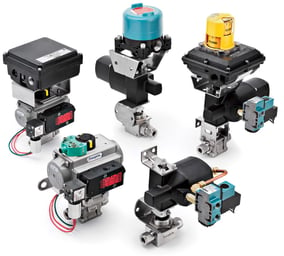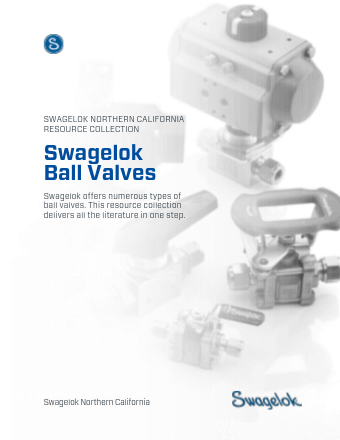Share this
Actuation Gives Swagelok Ball Valves Extra Versatility
by Jeff Hopkins on 6/5/19 8:45 AM
We offer them in pneumatic or electric versions, with a manual override too
"A ball valve's design is about as basic as it gets. At its heart is a ball with a hole through it -- sometimes straight, sometimes with a right angle."
- From The Inside Story On Swagelok Ball Valves
Swagelok offers several different ways to automate our ball valves. Let's go through the list. 
First up are the actuators that are operated pneumatically. You can get them set so the valve is normally open or normally closed, allowing you to use it as a fail-safe valve to shut off or isolate a system. The valve can be tripped upon the loss of power, and the valve will shut (or open) itself. If you don't have any compressed air available to move the valve, we also offer an electric actuator option. It will allow you to operate the valve remotely.
Making improvements
The one big difference from our pneumatic model is that the standard Swagelok electric actuator must be activated whenever you want to change position. That is, it can't really be used when you want the valve in a normally closed or normally opened position.
That didn't sit well with Neil Ide, our former Custom Solutions manager. He noticed that many systems that use actuated ball valves also have a manually operated ball valve right in front of it on the line. For the price of two ball valves, he thought, there should be a way to overcome that duplication. If he could eliminate the need for the manual valve, it would save space too.
So he called on the expertise of Hanbay Inc., a manufacturer of planetary gear actuators.
"I had Hanbay design a special electric actuator that has a normally open or a normally closed position," Ide says. "It's also available with a manual override. You can close or open it manually, and even lock it closed or lock it open. This new actuator is available only through Swagelok.”
So long, solenoids
It also makes a good replacement for a solenoid valve, which effectively seals in only one direction. If there's any reverse flow in your fluid line, a solenoid valve would require the addition of a check valve, which means spending more money.
Solenoid valves also have a much lower flow coefficient. The flow has to turn a hard 90 degrees inside the valve, and then another 90 degrees out of the valve. You need quite a large one to get good flow. That, in turn might require a bigger pump to compensate for the flow constriction.
A third drawback is that solenoid valves have pipe thread fittings, increasing the chance of leakage. And you'll still probably need to back it up with a manual actuated ball valve for lockout and tag-out safety.
Come on down for a demonstration in our customer briefing center. We'll be more than happy to help you get a handle on valves.
More like this:
Share this
- Archive (465)
- Assembly Services (207)
- About (100)
- Seal Support Systems (96)
- Best Practices (88)
- Training Services (74)
- Fittings (51)
- Semiconductor Applications (49)
- Hoses and Flexible Tubing (47)
- Regulators (44)
- Tubing (42)
- Grab Sampling Systems (32)
- Sampling Systems (32)
- Gas Systems (30)
- Services (30)
- Downloads (29)
- Valves (24)
- Application Support (18)
- Orbital Welding (17)
- Case Studies (13)
- Steam Systems (13)
- Frequently Asked Questions (12)
- Tools (12)
- Measurement Devices (7)
- Subsystems (6)
- Thermal Management (6)
- September 2023 (1)
- August 2023 (2)
- June 2023 (1)
- March 2023 (3)
- February 2023 (3)
- January 2023 (4)
- December 2022 (4)
- November 2022 (4)
- October 2022 (4)
- September 2022 (1)
- August 2022 (3)
- July 2022 (2)
- June 2022 (4)
- May 2022 (1)
- April 2022 (2)
- March 2022 (1)
- February 2022 (2)
- January 2022 (3)
- December 2021 (1)
- November 2021 (6)
- October 2021 (6)
- September 2021 (8)
- August 2021 (4)
- July 2021 (3)
- June 2021 (6)
- May 2021 (6)
- April 2021 (7)
- March 2021 (5)
- February 2021 (4)
- January 2021 (6)
- December 2020 (5)
- November 2020 (6)
- October 2020 (6)
- September 2020 (8)
- August 2020 (7)
- July 2020 (8)
- June 2020 (8)
- May 2020 (6)
- April 2020 (9)
- March 2020 (7)
- February 2020 (10)
- January 2020 (21)
- December 2019 (23)
- November 2019 (21)
- October 2019 (22)
- September 2019 (21)
- August 2019 (22)
- July 2019 (23)
- June 2019 (20)
- May 2019 (23)
- April 2019 (22)
- March 2019 (21)
- February 2019 (20)
- January 2019 (21)
- December 2018 (14)
- November 2018 (19)
- October 2018 (23)
- September 2018 (17)
- August 2018 (29)
- July 2018 (11)
- June 2018 (6)
- May 2018 (5)
- April 2018 (4)
- March 2018 (5)
- February 2018 (3)
- January 2018 (3)
- December 2017 (2)
- November 2017 (4)
- October 2017 (3)
- September 2017 (2)
- August 2017 (6)
- July 2017 (4)
- June 2017 (4)
- May 2017 (4)
- April 2017 (3)
- March 2017 (4)
- February 2017 (3)
- January 2017 (3)
- December 2016 (3)
- November 2016 (3)
- October 2016 (3)
- September 2016 (5)
- August 2016 (5)
- July 2016 (4)
- June 2016 (5)
- May 2016 (3)
- April 2016 (4)
- March 2016 (5)
- February 2016 (11)
- January 2016 (1)
- December 2015 (3)
- November 2015 (4)
- October 2015 (3)
- September 2015 (4)
- August 2015 (4)
- July 2015 (8)
- June 2015 (5)
- May 2015 (3)
- April 2015 (4)
- March 2015 (4)
- February 2015 (3)
- January 2015 (4)
- December 2014 (2)
- November 2014 (3)
- October 2014 (4)
- September 2014 (4)
- August 2014 (4)
- July 2014 (5)
- June 2014 (4)
- May 2014 (4)
- April 2014 (5)
- March 2014 (4)
- February 2014 (3)
- January 2014 (4)
- December 2013 (5)
- November 2013 (3)
- October 2013 (4)
- September 2013 (3)
- August 2013 (5)
- July 2013 (5)
- June 2013 (5)
- May 2013 (3)
- April 2013 (6)
- March 2013 (4)
- February 2013 (4)
- January 2013 (8)
- December 2012 (4)
- November 2012 (6)
- October 2012 (6)
- September 2012 (4)
- August 2012 (4)
- July 2012 (4)
- June 2012 (4)

.webp?width=210&height=70&name=StickyLogo%20(5).webp)
